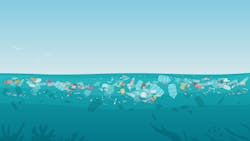Recent studies suggest that we consume a credit card’s worth of plastic each week through ingestion of microplastics found in our food and in our environment. Plastics are now found in rainwater and on the top of Mount Everest. In short, plastics are everywhere.
Nowhere is the impact of plastics so conspicuously found than in the ocean and the Great Pacific Garbage Patch — most of which is plastics. The discovery of this phenomenon has brought to light the massive scale of the problem of plastics in the oceans. But what is the source of this trash and plastics? Studies show that 80 percent of these plastics come from land-based sources — and that’s where the nexus of stormwater and trash can be found.
Litter and debris are generated from a lack of adequate trash cans in public space, from waste transfer stations, by careless drivers who thoughtlessly throw trash out windows on highways and parking lots, and many other sources. Regardless of the source, a significant amount of trash generated in urban areas finds its way into drainage structures, conveyance systems, treatment practices, and eventually into receiving waters.
These gross solids not only lead to localized flooding and associated hazards through blockages of inlets and pipes but they also carry pollutants with them, including PFAS and other chemicals such as 6PPD, which is an acute toxin impacting salmonids. Eventually, these gross solids break down and plastic trash becomes microplastics.
Due to the growing understanding of the impact of trash and plastics on aquatic biota, the environment, and human health, the National Municipal Stormwater Alliance (NMSA) and other groups have engaged with U.S. EPA’s Trash-Free Waters Program to focus on this important topic over an 18-month period. A report detailing the activities associated with this effort, referred to as the Stormwater and Solid Waste project, or SW2, will be released in the fall/winter of 2022.
These activities included engagements with practitioners and leaders in the stormwater and solid waste sectors to determine critical areas of interest and needs related to aquatic trash prevention. Information was gathered through a survey led by NMSA, a series of remote facilitated stakeholder dialogues, and conversations with key experts. Outputs from this effort will include a listing of the most critical challenges as well as proposed products that would have the most significant impact to address this issue.
NMSA has also been focused on the stormwater and trash issue through their Stormwater Testing and Evaluation for Products and Practices (STEPP) initiative and the associated ASTM E64 Committee on Stormwater Control Measures. Efforts over the last year in ASTM Committee E64 have resulted in a finalized standard to measure the performance of trash capture devices. This standard will enable STEPP to begin evaluating the efficacy of trash capture technologies in the next 12-24 months in a way that will provide greater confidence to consumers of these technologies on their performance and overall effectiveness.
More work is yet to be done. Standards in the quantification and reporting of captured trash, as well as assessments of trash loading hot spots, have yet to be fully developed. Without these standards, data on trash loadings and sources will continue to be collected in an inconsistent and haphazard way. Even more significantly, the costs associated with the capture and reduction of trash that ends up in MS4 conveyances and treatment facilities continues to be borne solely by communities rather than by those entities who profit from the consumption of products that generate these trash loads. In economic terms, these entities are externalizing costs of litter and trash generation from a business expense context to a local government cost burden.
It is time to consider methods, such as Extended Producer Responsibility (EPR), in the stormwater sector. Methods like these can internalize at least a portion of these externalized costs by establishing a fund, capitalized by major plastics and trash generators, that can be used by localities to address trash loadings in their community. It will take concepts such as this to turn the tide on trash in our MS4 systems and in our receiving waters. And if we take bold action like this, perhaps the next generation won’t have the term “The Great Pacific Garbage Patch” in their lexicon at all. SW
Published in Stormwater magazine, August 2022.






